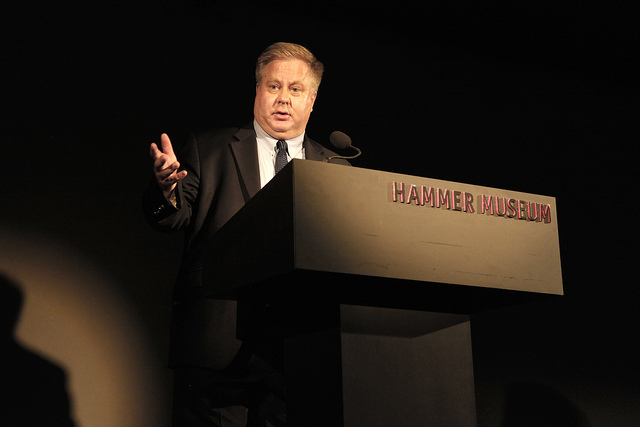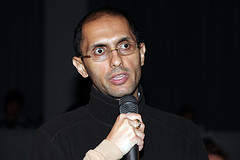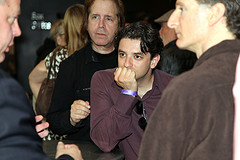
The key division in American politics and economics right now isn’t between liberals and conservatives, Michael Lind told an audience at the Hammer Museum. It’s between Hamiltonians and Jeffersonians. What does this division mean now, what is its history, and how did America’s economy get into the current mess? These are the questions that Lind, a public intellectual, co-founder of the New America Foundation, and author of Land of Promise: An Economic History of the United States, tried to answer in his talk.
Lind divides the past 250 years of American economic and political history into three industrial revolutions, three American republics, and two great American traditions–Hamiltonian and Jeffersonian–of political economy.
The first industrial revolution was based on the steam engine; the second was based on the internal combustion engine and the electric motor; and the third was based on the development of computer and information technology. In each of these waves of innovation, an initial period of invention was followed by 30 or 50 years of deployment. Although automobiles were invented in the 1860s, for example, it wasn’t until the 1920s that they were widely deployed across America. Similarly, transistors were first developed from the 1940s to the 1960s, but it was only beginning in the 1980s that a large number of people utilized the technology.

America’s three republics–what Lind called “discontinuous regimes”–have been separated by crises: The Civil War and Reconstruction ended the first republic, while the Great Depression ended the second. “We’re in the last days of the third American republic,” said Lind.
Throughout all these republics, America has been torn between the Hamiltonian and Jeffersonian traditions of political economy–as originally envisioned by the first secretary of the U.S. Treasury, Alexander Hamilton, and the third U.S. president, Thomas Jefferson. The Hamiltonian tradition views government and businesses as collaborators in a common project of nation-building. The Jeffersonian tradition sees America as a democratic republic where a majority of the citizens are independent and own property; it was originally an agrarian vision but has expanded to encompass farmers, the self-employed, craftsmen, and small-business owners.
Alexander Hamilton wanted to protect American industry behind tariffs so that American manufacturers could compete with British manufacturers. Thomas Jefferson and his supporters tended to favor free trade but also wanted government regulations in favor of small producers over large ones. U.S. anti-trust laws, anti-chain store laws, and unit banking laws (which kept banks from opening multiple branches in different cities until the late 20th century) are all the results of Jeffersonian policies.
The nation has gone through alternating phases in which first one tradition and then the other held sway. Typically, Hamiltonians come to power after crises: there’s a consensus, said Lind, “that there are great projects needed to build the country after these crises.” The Transcontinental Railroad was completed after the Civil War, and the interstate highway system was pushed through Congress after the Great Depression.
After these bursts of Hamiltonian activity, “in the next generation, there is a neo-Jeffersonian backlash,” said Lind, with a libertarian and localist bent. In the 1830s, Andrew Jackson spearheaded this backlash in his famous battles with Henry Clay over national banking and government support of infrastructure and manufacturing.

“It’s not a simple partisan story,” said Lind. “Different traditions ascend and descend.”
For the past 40 years, Republicans and Democrats alike have embraced a neo-Jeffersonian tradition. Barack Obama and Bill Clinton are both Jeffersonians–as was Ronald Reagan–while Herbert Hoover was a right-wing Hamiltonian, and Franklin Roosevelt was a center/left-wing Hamiltonian. Lind believes we are again in crisis–a depression, not a recession–and he predicts that as the current third republic comes to an end, “there will be a period of a decade or two of upheaval, and then we’ll emerge with a very different America.”
In the question-and-answer session, the audience asked him to say more about what this new America might look like.
Are there any Hamiltonian leaders he sees taking the reins? Lind name-checked John Kerry and Senator Kay Bailey Hutchinson from Texas. But while “there’s no single figure in either party” who comes to mind, there are proposals and policies in the conversation that are Hamiltonian in nature, such as an infrastructure bank (supported by Hutchinson) that fits the bill.
In response to a question about whether it might be possible to turn California around, Lind spoke frankly. “We’re never going to recover,” he said. “The world before 2008 is dead. It is never coming back. The world is going to be different.” And our language needs to reflect that. He believes that we shouldn’t be talking about recovery, but about rebuilding and reconstruction instead.
Asked about the immediate future, Lind was similarly sobering. A lot of people, including himself, thought that Barack Obama’s election would be like 1932, the year Franklin Roosevelt became president. “What if 2008 was really 1929?” asked Lind. During the Hoover years, the stock market inched up every time there was good news–but in 1931 crises in Germany and Central Europe plunged the world even deeper into depression.

The final question challenged Lind on how he thinks we might be able to begin solving our economic woes. “If wages kept up with federal growth, budgets would be better today,” he said. The disparity between the richest and the rest of us is causing less consumption and more speculation, creating a more volatile economy.
“What’s the answer to this? Reform if possible, revolution if necessary,” he said.
Lind apologized for ending the evening on a pessimistic note, but he suggested that the 21st century might see a new kind of state much like what we see today in China and India: large countries with a small fraction of the population making up a middle class–while the rest of the nation doesn’t partake in the wealth. America has to make sure that “we don’t recapitulate that pattern and have a first-world America and a third-world America existing within the same borders,” said Lind. That said, he assured the audience: “You don’t need to buy guns and gold-yet.”
Watch full video here.
See more photos here.
Read expert opinions on where in the past the U.S. economy can find inspiration in emerging from the current economic downturn here.
Buy the Book: Skylight Books, Powell’s, Amazon.
*Photos by Aaron Salcido.




Send A Letter To the Editors